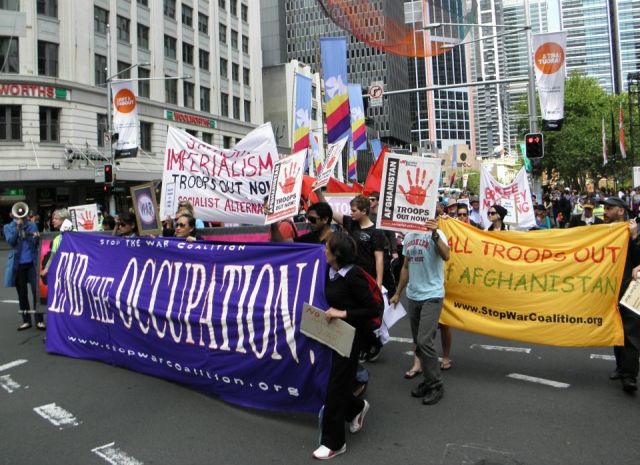
On the eve of US President Barack Obama’s visit to mark 60 years of the ANZUS military alliance, PM Julia Gillard is not convincing people that Australia must “stay the course” in Afghanistan.
A November 4 Roy Morgan poll, taken six days after an Afghan army trainee killed three Australian soldiers and wounded seven, said 72% of people want troops out, the biggest opposition since the war began 10 years ago.
Supporters of the pro-war parties polled closely: 69% of ALP voters and 67% of Liberal-National Party voters want troops out. Among Greens supporters, the figure is 80%.
On November 9, two days after Gillard’s recent surprise trip to Afghanistan’s Oruzgan province where most of the 1550 Australian soldiers are based, another Afghan trainee shot and wounded three Australians and several US soldiers.
"As distressing as these incidents are,” Gillard said that day, “our mission in Afghanistan does need to continue.
"Training is pivotal to that mission and our purpose in Afghanistan is to deny Afghanistan as a country in which terrorists can train to wreak violence around the world."
But the spate of attacks by Afghan soldiers on their “trainers” raises awkward questions for Gillard, some even coming from the pro-war camp. Major-General Alan Stretton has said the government is relying on “political spin” to link terror attacks on Australians in Indonesia with Afghanistan.
“We should remember that control of Afghanistan was beyond the resources of the British, despite efforts lasting nearly 100 years,” he wrote in the Age in October last year. “Similarly, the 1979 invasion by Soviet forces … failed miserably and a decade later they went home with their tails between their legs.”
Stretton said the strategy of training local forces to hand them the security of the country has not worked in Vietnam or Iraq, where the “army and police are riddled with warring factions infiltrated by so-called terrorists and under the control of a corrupt government”.
The security situation in Iraq is now worse than it was before the invasion, he said.
Stretton said it is the occupation of Afghanistan that leads to continued terror attacks, not “rogue soldiers”.
University lecturer Binoy Kampmark said in an October 31 Scoop.co.nz article that morale in the Afghan army is very low, and the yearly dropout rate is 28%.
The Taliban claimed credit for half of the 60 shootings of foreign soldiers. But International Security Assistance Force officials say only half of those claimed are true.
Most cases are put down to “individual grievances”, which includes cultural insensitivity and racial abuse.
Afghan army recruits are poorly paid and equipped compared with the occupation forces, which leads to resentment of their foreign “trainers”.
Under pressure, defence minister Stephen Smith has said Australia will start to withdraw soldiers in 2014 in line with the US’s timetable. Apparently, this is when the “job will be done”.
But a critical report by the International Crisis Group (ICG), Aid and Conflict in Afghanistan, said: “There is no possibility that any amount of international assistance to the Afghan National Security Forces will stabilise the country in the next three years … Nor will the Afghan state be in a position by 2015 to provide basic services to its citizens ...
“The Afghan National Army (ANA) and Afghan National Police (ANP) are still largely incapable of countering the insurgency, ensuring internal stability and enforcing the government’s writ ... Both institutions are under-developed, under-trained and face crippling attrition rates.”

An earlier ICG report, A Force in Fragments, said a key reason for these failures was that the US-NATO command had sought to exploit ethnic and tribal disputes to build army recruits.
The report also cited the rampant corruption and lack of authority of the US-backed government of Hamid Karzai.
A large part of the Afghan army was recruited from northern warlord militias — the anti-Taliban Northern Alliance.
Last year, the ANA was comprised of 42.6% Pashtuns; 40.98% Tajiks; 7.68% Hazara; 4.05% Uzbek and 4.68% other minorities. However, Tajiks dominated the officer ranks.
The IGC said “there are far more Tajiks as opposed to Pashtun officers in Pashtun-majority southern provinces such as Kandahar, Helmand and Zabul”.
The ANA and the ANP received about US$29 billion — half the total international aid between 2002 and last year — much of which was siphoned away through corruption.
The ICG said “numerous allegations of corruption” were reported, but “very few have resulted in disciplinary action”.
The report said the US resorts to “creating and supporting parallel security forces … multiplying the number of people with guns in a country awash with weapons”. These include local militias, also called Afghan Local Police (ALP) in rural areas, which, “risk coming under the control of warlords with shifting allegiances”.
Australian occupation forces have done the same. In Oruzgan province, where most of the Australian troops are stationed, the notorious warlord Matiullah Khan, was made chief of police in July this year, after years of being paid to have his fighters work alongside Australian forces.
These are some of the facts that the pro-war politicians are loathe to discuss, which is all the more reason for anti-war activists to join the protest outside Parliament House in Canberra on November 17, when Obama is there, to demand that the troops be pulled out.